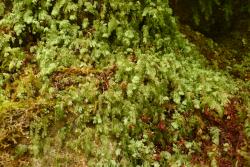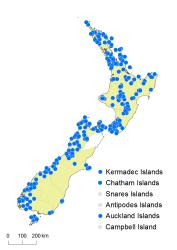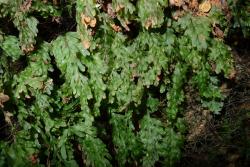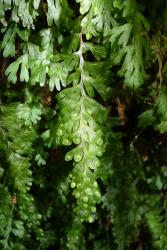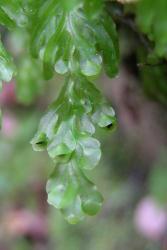- ≡ Mecodium rarum (R.Br.) Copel., Philipp. J. Sci. 67: 21 (1938)
- = Hymenophyllum semibivalve Hook. & Grev., Icon. Fil. 1, t. 83 (1828)
- = Hymenophyllum imbricatum Colenso, Tasmanian J. Nat. Sci. 2: 187 (1845) nom. illeg., non Hymenophyllum imbricatum Blume 1828
Epiphytic, terrestrial or rupestral ferns. Rhizomes long-creeping, 0.1–0.2 mm diameter, glabrous or bearing very scattered red-brown hairs up to 0.3 mm long. Fronds 13–235 mm long. Stipes 3–90 mm long, dark brown throughout, not winged, glabrous. Laminae 2–3-pinnatifid or occasionally irregularly divided, narrowly ovate or ovate or narrowly elliptic or elliptic, rarely narrowly obovate in very long fronds with the lower pinnae abraded, 10–200 mm long, 8–40 mm wide, grey-green, membranous, glabrous. Rachises winged for most of their length, dark brown proximally, red-brown distally, glabrous; rachis wings planate or sometimes slightly flexuose. Primary pinnae in 4–30 pairs, often markedly overlapping, winged throughout, adnate; distal portion of primary pinnae straight or slightly incurved acroscopically; distal primary pinnae elliptic or obovate; proximal primary pinnae ovate; the longest primary pinnae below the middle, 7–40 mm long, 3–10 mm wide, but individual primary pinnae occasionally greatly extended. Secondary pinnae usually arising acroscopically or occasionally also basiscopically, slightly overlapping, winged throughout, elliptic to obovate, adnate; the longest secondary pinnae 3–12 mm long, 1–5 mm wide. Ultimate lamina segments oblong or linear, up to 4 mm long, 1.2–2.7 mm wide; apices obtuse or truncate or slightly emarginate; margins entire, lacking a distinct border; distal segments on primary pinnae sometimes curved towards frond apex. Sori borne on acroscopic and basiscopic segments at the distal ends of the pinnae, solitary, a few on each primary pinna, immersed in lamina segments; indusia bivalvate; indusia elliptic to almost orbicular, 1.5–2.5 mm long, apices obtuse, margins entire; receptacles included within indusial flaps.
Hymenophyllum rarum is a small filmy fern recognisable by its grey-green, very thin, glabrous laminae with entire margins, and sori immersed in the broad ultimate lamina segments. Despite its very thin frond, the species has remarkable resistance to drought, rarely curling up even in the driest conditions.
Plants are occasionally found in which the primary pinnae are greatly extended, sometimes apparently growing out from the apices of the originally-formed pinnae, and occurring randomly along the length of the lamina.
North Island: Northland, Auckland, Volcanic Plateau, Gisborne, Taranaki, Southern North Island.
South Island: Western Nelson, Sounds-Nelson, Westland, Canterbury, Otago, Southland, Fiordland.
Kermadec Islands, Chatham Islands, Stewart Island, Auckland Islands.
Altitudinal range: 0–1400 m.
Hymenophyllum rarum occurs in lowland to subalpine areas throughout the North Island, except along the east coast, ranging from near sea level up to 1400 m on Mt Taranaki and in Tongariro National Park. In the South Island it occurs in lowland and montane areas of the Marlborough Sounds, north-west Nelson, Westland and Fiordland, extending to the Catlins, Dunedin and Banks Peninsula on the east coast. It is absent from much of the drier inland regions of Marlborough, Canterbury and Otago. It reaches 1150 m in the Rolleston Range, Canterbury.
There is a single collection from Raoul Island made "between Green and Blue Lakes" by R.C. Cooper in 1956 (AK 44332). However, the species has not subsequently been recorded for the Kermadec Islands (Allan 1961; Sykes 1977; Sykes & West 1996; Brownsey & Smith-Dodsworth 2000) and may now be very localised, or even extinct on Raoul (Peter de Lange, pers. comm.). The area from which it was collected has been particularly prone to damage from volcanic activity (Sykes 1977).
Also Australia (New South Wales, Victoria, Tasmania).
Occurs under kauri, podocarp, beech and broadleaved forest, and in mānuka, kānuka and subalpine scrub, often as an epiphyte but also growing on the ground, on dead stumps, at the base of tree trunks, on rock faces, clay banks, under overhangs and on scoria. It can grow in exposed sites as well as in shaded forest or scrub. It has been recorded growing epiphytically on a wide range of species including Cyathea dealbata, Dicksonia squarrosa, Beilschmiedia tawa, B. tarairi, Dacrycarpus dacrydioides, Elaeocarpus dentatus, Hedycarya arborea, Metrosideros excelsa, Olearia colensoi, Podocarpus laetus, P. totara, Prumnopitys ferruginea, Weinmannia racemosa, W. silvicola and species of Nothofagaceae, as well as hanging from clumps of Astelia.
n = 36 (Brownlie 1954).
New Zealand plants of Hymenophyllum rarum often have slightly broader and more imbricate lamina segments than Australian plants which have narrower and more widely spaced segments. New Zealand plants also tend to be grey-green in colour unlike Australian plants which are dark green. Tindale (1963) noted that Australian plants had a "peculiar odour", although whether this was in fresh or dried material was not stated. No reference was made to New Zealand plants, but some local botanists have noted a distinct metallic fragrance in New Zealand plants, especially in dried material (Peter de Lange, pers. comm.). Tindale & Roy (2002) reported n = 56–58 and n = 58 in two populations from New South Wales, whereas Brownlie (1954) reported n = 36 in a plant from New Zealand. Brownlie’s count was not supported by a photograph of the meiotic preparation so it is impossible to verify, but the number alone suggests that populations in Australia and New Zealand might be fundamentally different. Subgenus Mecodium, to which H. rarum belongs, has a base chromosome number of n = 28 (Ebihara et al. 2006).
The lectotype of H. rarum was collected in Tasmania by Robert Brown, whereas the holotype of H. semibivalve was collected in New Zealand by Archibald Menzies (probably from Dusky Sound). However, the morphological differences usually apparent between Australian and New Zealand populations are not evident in these two collections which are both more similar to Australian plants. The lectotype of H. imbricatum, from the North Island of New Zealand, has broad and strongly imbricate lamina segments, but the name is illegitimate, being a later homonym of H. imbricatum Blume.
The existing evidence is therefore equivocal but suggests that further work is needed to establish whether New Zealand and Australian plants belong to different species, or whether more than one taxon is present in either New Zealand or Australia or both.



